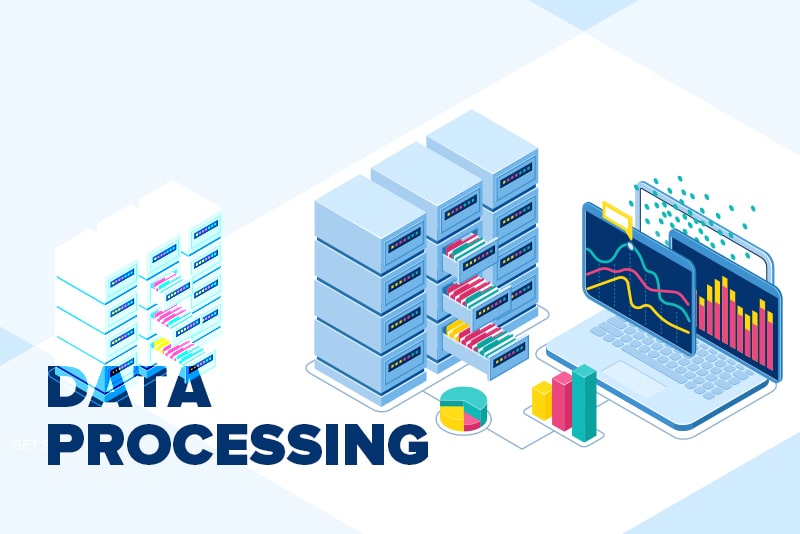Data processing is essential for handling huge volumes of data in this data-savvy era of the digital world. This involves the process of converting raw data into meaningful machine-readable content. Data processing services make use of automated methods to process data for businesses. In this data-driven world, businesses are looking to get valuable insights from data. Major industries such as e-commerce, education, healthcare, banking, travel, retail, etc require data analytics tools for gaining valuable insights. This is achieved through data processing. Read further to learn about different types of data processing methods.
What Is Data Processing?
It is impossible for any organization to use data in its raw form. Data processing refers to the manipulation of data in which the raw data is collected and translated into a usable form. The data processing cycle is managed and handled by data scientists and data engineers in an organization. The data is converted to a readable format by collecting, filtering, sorting, processing, and then storing them.
Data Processing Cycle
- Data collection
The collection step of the data processing cycle is the initial and crucial step. This allows businesses to assess the data, interpret it and suggest changes that need to be done. It is important to use reliable data lakes to get desirable outcomes. In this step, the resource type is collected. The quality of the data is evaluated and raw information that has to be converted is segregated.
- Storage of data
Data is large-volume whether in structured or unstructured forms. Therefore, it has to be stored digitally for performing meaningful analysis and to make it presentable according to the application requirements.
- Processing of data
The data has to be converted into a useful form which needs several processing steps. They are:
- Verify
- Transform
- Organize
- Integrate
- Extraction of the output data
- Data analysis
This involves the systematic application or evaluation of the data using analytical tools. Logical reasoning is performed to illustrate each component of the output data to get the desired result or decision.
- Presentation of the data
Once the data analysis step is completed, data has to be presented in different forms like chart, text file, excel file, graph, etc.
Data conversion services use a single software or a combination of software for storing, segregating, filtering, and processing data as per the predefined set of operations.
Data Processing Methods
- Manual data processing
The processing of data is dealt with manually in which the entire process is performed with human intervention. It means data processing steps such as data collection, filtering, sorting, calculation, and other logical operations are done without an electronic device or automation software. This is cost-effective but takes a lot of time to complete one task.
- Mechanical data processing
In this, the processing of data is done with the use of devices and machines. It can be simple devices such as calculators, typewriters, printing presses, etc. This is particularly useful for small data processing operations. There will be fewer errors but the huge volume of data has made it less feasible for data processing.
- Electronic data processing
Modern technologies are used to process the data and yield the output. The tasks are carried out by data processing software and programs. The processing of data is faster and more reliable.
Five Main Types of Data Processing
Depending on the type of data required, businesses can use different techniques of data processing. Here are the five main types of data processing.
- Commercial data processing
In this technique, standard relational databases are applied and include batch processing. There will be a large volume of output that is processed with fewer computational operations. Businesses combine both commerce and computers to carry out the task. There will be fewer errors in the end result as the data is processed in a standardized manner.
- Scientific data processing
Scientific data processing differs from commercial data processing in terms of the use of computational operations as well as the volume of inputs and outputs. In this technique, large use of computational operations is performed for lower volumes of inputs. It should be error-free because any error can impact decision-making. Therefore, the processes of validating, sorting, and standardizing the data have to be done very cautiously. To make sure that there are no errors, a wide variety of scientific methods are used to get accurate conclusions and relationships. In comparison with commercial data processing, this technique takes a long time to process data.
- Batch Processing
In this type of data processing, a number of cases are processed simultaneously and it is usually used when the data is homogenous and available in large volumes. The data is processed by collecting it in batches. It can be also referred to as concurrent, simultaneous, or sequential execution of the data. The tasks are executed by the same resource but for different cases. In sequential batch processing, the tasks are executed one after the other by the same resource. On the other hand, in concurrent batch processing, the operations are executed by the same resources but they overlap in time. This technique finds application in the financial sector or places where additional security is required.
- Online processing
This technique of data processing can be termed an interactive method in which relatively smaller operations are simplified to meet the specified requirements. This involves dealing with major fractions of large databases wherein precomputation is the key to quicker execution of tasks. In fact, most of the tasks are processed even before the user has started the application. Typically, online processing is relied upon when the data has to be processed continuously and is fed into the system in an automatic manner.
- Real-time processing
There can be a delay in processing the data when they are fetched in batches. This limits the capacity of the current data management system. Real-time processing records, updates and processes the data on a real-time basis ensuring quicker execution of tasks. This reduces the time lag between the occurrence and processing of data. The data is stored and processed in a real-time environment.
In addition, these days, businesses require real-time insights into the data being processed. This is done by gathering the data directly from the source in the form of a stream and drawing conclusions without actually transferring or downloading it. In real-time processing, data virtualization techniques can be used to get meaningful information as and when it is required.
In this fast-paced digital era, businesses need to rely upon data processing services for handling huge volumes of data and to get accurate end results.




